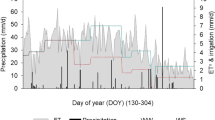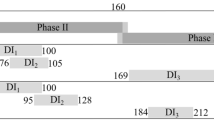Abstract
The influence of air vapor pressure deficit (VPD) and plant fruit load on the expansion and water relations of young tomato fruits grown in a glasshouse were evaluated under summer Mediterranean conditions. The contributions of phloem, xylem and transpiration fluxes to the fruit volume increase were estimated at an hourly scale from the growth curves of intact, heat-girdled and detached fruits, measured using displacement transducers. High VPD conditions reduced the xylem influx and increased the fruit transpiration, but hardly affected the phloem influx. Net water accumulation and growth rate were reduced, and a xylem efflux even occurred during the warmest and driest hours of the day. Changes in xylem flux could be explained by variations in the gradient of water potential between stem and fruit, due to changes in stem water potential. Misting reduced air VPD and alleviated the reduction in fruit volume increase through an increase in xylem influx and a decrease in fruit transpiration. Under low fruit load, the competition for assimilates being likely reduced, the phloem flux to fruits increased, similarly to the xylem and transpiration fluxes, without any changes in the fruit water potential. However, different diurnal dynamics among treatments assume variable contributions of turgor and osmotic pressure in F3 and F6 fruits, and hypothetical short-term variations in the water potential gradient between stem and fruit, preventing xylem efflux in F3 fruits.






Similar content being viewed by others
References
Abbott JD, Peet MM, Willits DH, Gough RE. 1985. Water management of greenhouse tomatoes. HortScience 20:688–690
Araki T, Kitano M, Eguchi H. 1997. Evaluation of photoassimilate flux through a tomato pedicel. Biotronics 26:21–29
Bertin N, Guichard S, Leonardi C, Longuenesse JJ, Langlois Y, Navez B. 2000. Seasonal evolution of the quality of fresh glasshouse tomatoes under Mediterranean as affected by air vapour deficit and plant fruit load. Ann Bot 85:741–750
Boulard T, Jemaa R. 1993. Greenhouse tomato crops transpiration: application to irrigation control. Acta Hort 335:381–387
Bruggink GT, Schouwink HE, Gieling TH. 1988. Modelling of water potential and water uptake rate of tomato plants in greenhouse: preliminary results. Acta Hort 229:177–184
Bussières P. 2002. Water import in the young tomato fruit limited by pedicel resistance and calyx transpiration. Func Plant Biol 29:631–641
Davies JN, Hobson GE. 1981. The constituents of tomato fruit—the influence of environment, nutrition and genotype. CRC Crit Rev Food Sci Nutr 15:205–280
Ehret DL, Ho LC. 1986a. Translocation of calcium in relation to tomato fruit growth. Ann Bot 58:679–688
Ehret DL, Ho LC. 1986b. Effects of osmotic potential in nutrient solution on diurnal growth of tomato fruit. J Exp Bot 37:1294–1302
Favé C. 1998. Effets de la température et de l’humidité relative de l’air sur les flux d’eau, de calcium et de potassium vers le fruit de melon (Cucumis melo L.). PhD Thesis. Université de Bordeaux, France
Fishman S, Génard M, Huguet JG. 2001. Theoretical analysis of systematic errors introduced by a pedicel-girdling technique used to estimate separately the xylem and phloem flows. J Theor Biol 213:435–446
Gary C, Baldet P, Bertin N, Devaux C, Tchamitchian M, Raymond P 2003. Time-course of tomato whole-plant respiration and fruit and stem growth during prolonged darkness in relation to carbohydrate reserves. Ann Bot 91:429–438
Grange RI. 1995. Water relations and growth of tomato fruit pericarp tissue. Plant Cell Environ 18:1311–1318
Grange RI, Andrews J. 1993. Growth rates of glasshouse tomato fruit in relation to final size. J Hort Sci 68:747–754
Grange RI, Andrews J. 1994. Expansion rate of young tomato fruit growing on plants at positive water potential. Plant Cell Environ 17:181–187
Grange RI, Andrews J. 1995. Respiration and growth of tomato fruit. Plant Cell Environ 18:925–930
Guichard S, Bertin N, Leonardi C, Gary C. 2001. Tomato fruit quality in relation to water and carbon fluxes. Agronomie 21:385–392
Ho LC, Adams P. 1994. The physiological basis for high fruit yield and susceptibility to calcium deficiency in tomato and cucumber. J Hort Sci 69:367–376
Ho LC, Adams P. 1995. Nutrient uptake and distribution in relation to crop quality. Acta Hort 396:33–44
Ho LC, Grange RI, Picken AJ. 1987. An analysis of the accumulation of water and dry matter in tomato fruit. Plant Cell Environ 10:157–162
Ho LC, Belda R, Brown M, Andrews J, Adams P. 1993. Uptake and transport of calcium and the possible causes of blossom-end rot in tomato. J Exp Bot 44:509–518
Ho LC, White PJ. 2005. A cellular hypothesis for the induction of blossom-end rot in tomato fruit. Ann Bot 95:571–281
Huguet JC, Génard M, Laurent R, Besset J, Busi C, Girard T. 1998. Xylemic, phloemic and transpiration flows to and from a peach. Acta Hort 465:345–353
Johnson RW, Dixon MA, Lee DR. 1992. Water relations of tomato during fruit growth. Plant Cell Environ 15:947–953
Jones HJ. 1992. Plants and Microclimate: A Quantitative Approach to Environmental Plant Physiology. Cambridge, UK, Cambridge University Press
Kawabata S, Sasaki H, Sakiyama R. 2005. Role of transpiration from fruits in phloem transport and fruit growth in tomato fruits. Physiol Plant 124:371–380
Köckenberger W, Hudson A, Bowtell R, Korolev A, Tomos AD, Farrar JF. 1998. NMR microimaging in the investigation of photoassimilate transport. J Exp Bot 49:4–5
Lang A. 1990. Xylem, phloem and transpiration flows in developing apple fruits. J Exp Bot 41: 645–651
Lang A, Thorpe MR. 1986. Water potential, translocation and assimilate partitioning. J Exp Bot 37:495–503
Lang A, Thorpe MR. 1989. Xylem, phloem and translocation flows in grape: application of a technique for measuring the volume of attached fruits to high resolution using Archimedes’ principle. J Exp Bot 40:1069–1078
Lee DR. 1989. Vasculature of the abscission zone of tomato fruit: implications for transport. Can J Bot 67:1898–1902
Lee DR. 1990. An unidirectional water flux model of fruit growth. Can J Bot 68:1286–1290
Lee DR, Dixon MA, Johnson RW. 1989. Simultaneous measurements of tomato fruit and stem water potentials using in situ stem hygrometers. Can J Bot 67:2352–2355
Leonardi C, Baille A, Guichard S. 1999. Effects of fruit characteristics and climatic conditions on tomato transpiration in greenhouse. J Hort Sci Biotechnol 74:748–756
Leonardi C, Baille A, Guichard S. 2000a. Predicting transpiration of shaded and non-shaded tomato fruits under greenhouse environments. Sci Hort 84:297–307
Leonardi C, Guichard S, Bertin N. 2000b High vapour pressure deficit influences growth, transpiration and quality of tomato fruits. Sci Hort 84:285–296
MacFadyen LM, Hutton RJ, Barlow EWR. 1996. Effects of crop load on fruit water relations and fruit growth in peach. J Hort Sci 71:469–480
Marcelis LFM. 1989. Simulation of plant-water relations and photosynthesis of greenhouse crops. Sci Hort 41:9–18
Miller RH. 1983. Cuticular pores and transcuticular canals in diverse fruit varieties. Ann Bot 51:697–709
Montgomery DC. 1984. Design and Analysis of Experiments. New York, USA, Wiley and Sons
Ohta K, Hosoki T, Matsumoto K, Ohya M, Ito N, Inaba K. 1997. Relationships between fruit cracking and changes of fruit diameter associated with solute flow to fruit in cherry tomatoes, J Jpn Soc Hort Sci 65:753–759
Ollat N, Diakou-Verdin P, Carde JP, Barrieu F, Gaudillère JP, Moing A. 2002. Grape berry development: a review. J Int Sci Vigne Vin 36:109–131
Patrick JW, Offler CE. 1996. Post-sieve element transport of photoassimilates in sink regions. J Exp Bot 47:1165–1177
Pearce BD, Grange RI, Hardwick K. 1993. The growth of young tomato fruit. I. Effects of temperature and irradiance on fruit grown in controlled environments. J Hort Sci 68:1–11
Peel AJ. 1965. The effect of changes in the diffusion potential of xylem water on sieve-tube exudation from isolated stem segments. J Exp Bot 16:249–260
Pickard WF, Minchin PEH, Troughton JH. 1979. Real time studies of carbon-11 translocation in moonflower. II. Further experiments on the effects of a nitrogen atmosphere, water stress, and chilling, and a quantitative theory of phloem translocation. J Exp Bot 30:307–318
Plaut Z, Grava A, Yehezkel C, Matan E. 2004. How do salinity and water stress affect transport of water, assimilates and ion to tomato fruits? Physiol Plant 122:429–442
Romero-Aranda R, Longuenesse JJ. 1995. Modelling the effect of air vapour pressure deficit on leaf photosynthesis of greenhouse tomatoes: the importance of leaf conductance to CO2. J Hort Sci 70:423–432
Ruan YL, Mate C, Patrick JW, Brady CJ. 1995. Non-destructive collection of apoplast fluid from developing tomato fruit using a pressure dehydration procedure. Aust J Plant Physiol 22:761–769
Ruan YL, Patrick JW. 1995. The cellular pathway of post phloem sugar transport in developing tomato fruit. Planta 196:434–444
Saure MC. 2001. Blossom-end rot of tomato (Lycopersicon esculentum Mill.)—a calcium- or a stress-related disorder? Sci Hort 90:193–208
Stirzaker RJ, Hayman PT, Sutton BG. 1997. Misting of tomato plants improves leaf water status but not leaf growth. Aust J Plant Physiol 24:9–16
Swanson CA, Hoddinott J, Siij JW. 1976. The effect of selected sink leaf parameters on translocation rates In: Wardlow IF, Passioura JB (eds.), Transport and Transfer Processes in Plants. New York, USA, Academic Press, p 347–356
van de Sanden PACM, Uittien JJ. 1995. Root environment water potential and tomato fruit growth. Acta Hort 401:531–536
Wolterbeek HT, Willemse PCM, van Die J. 1987. Phloem and xylem import of water and solutes in tomato fruits. Acta Bot Neerl 36:295–306
YaLing L, Marcelis LFM, Stanghellini C. 2004. Plant water relations as affected by osmotic potential of the nutrient solution and potential transpiration in tomato (Lycopersicon esculentum Mill.). J Hort Sci Biotechnol 79:211–218
Zemansky MW. 1963. Heat In: Gray DE (ed.), American Institute of Physics Handbook, New York, USA, McGraw-Hill, p 4–75.
Acknowledgments
This work was conducted in the framework of research programmes sponsored by INRA (AIP-AGRAF) and by the Provence Alpes Côte d’Azur Region. We acknowledge the helpful technical assistance of Béatrice Brunel, Jean-Claude L’Hôtel, Claudine Orlando, and Pierre Reich. Many thanks to Dr. P. Bussières for his valuable comments on the manuscript.
Author information
Authors and Affiliations
Corresponding author
Rights and permissions
About this article
Cite this article
Guichard, S., Gary, C., Leonardi, C. et al. Analysis of Growth and Water Relations of Tomato Fruits in Relation to Air Vapor Pressure Deficit and Plant Fruit Load. J Plant Growth Regul 24, 201–213 (2005). https://doi.org/10.1007/s00344-005-0040-z
Received:
Accepted:
Published:
Issue Date:
DOI: https://doi.org/10.1007/s00344-005-0040-z




